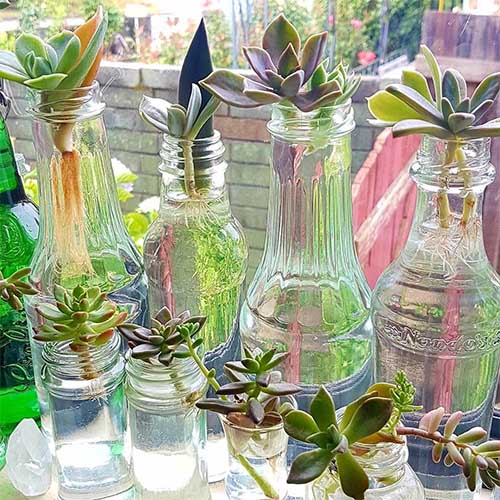The thick leaves and stems of succulent plants, which can withstand drought, serve as water reservoirs. They are relatively low-maintenance plants that come in an infinite variety of attractive foliage shapes and textures.
Propagating succulents in water is a fun and affordable way to grow your garden. There are numerous methods as well as an increasing number of attempts to do it in water.
You will fully understand succulent water propagation by the time this article is over, along with the procedures for doing it successfully.
You May Also Like:
Table of Contents
What Is Water Propagation?
Succulent cuttings are rooted in water using a technique known as water propagation. Considering succulents in this way might be counterproductive. The general consensus is that succulent plants dislike sitting in water and that doing so encourages root rot.
Therefore, water propagation might be in opposition to what we have come to believe about taking care of and propagating succulents. But lately, I seem to be hearing more and more about water propagation.
Why Succulent Cuttings Do Not Rot In Water?
According to one theory I’ve heard, the reason why succulent cuttings don’t rot in water is that water isn’t the main cause of rot. When succulent plants are left in wet soil, they are exposed to fungus and other soil-borne pathogens, which can cause root rot and other plant diseases. The plants do not rot when propagating in water because they are not exposed to the pathogens that are typically found in the soil medium.
How To Propagate Succulents In Water?
The rooting process for your succulent plants can begin in water by following these crucial steps to properly obtain cuttings.
- On your succulent plant, look for robust growth or offshoot.
- Make a quick, precise cut through the base of the desired stem with your pruning shears.
- Split the plant’s mother plant in half. This is your cutting.
- On the succulent branch, remove any lower leaves that are present so that one to two inches of the stem are freed above the cut.
- Give cuttings a couple of days to calluse. This is a crucial tip, as failing to do so could result in the cutting holding onto too much water and possibly rotting rather than rooting.
- Place the cutting’s calloused end in a glass jar filled with distilled water or rainwater, keeping the end just barely submerged.
- Use untreated tap water instead because chemical additives can prevent roots from growing.
- If the succulent cutting is very small, you can wrap the jar or glass in plastic wrap, poke holes in it, and insert the teeny stems to hold it in place.
- Put the water container in a location that receives a lot of indirect light. To keep an eye on rooting, water levels, and water clarity, use a transparent glass jar.
- Wait for roots to form while keeping the container in a bright location but out of direct sunlight.
- To prevent algae growth and cloudiness, change the water every couple of days.
- After three to four weeks, when the roots begin to form, they should be relocated to an area that receives more direct sunlight. Some roots can take up to 6 weeks to appear.

Water Roots Vs. Dry Roots
The fact that the roots formed in water are different from those required for a plant to grow in the soil is another worry people have about water propagation. Once buried in soil, they must grow new roots that are better suited for soil growth. Others who propagate in water claim that plants flourish when transferred from water to soil.
Since I personally have had great success with “dirt propagation,” I decided to conduct an experiment to find out how water propagation functions. To see what would happen, I attempted to root three stem cuttings in water. I picked two distinct plants that I had no trouble establishing in the soil. I reasoned that picking a plant I know will grow easily would increase my chances of success. I used stem cuttings from an aeonium (blushing beauty) plant and a jade plant (crassula ovata).
Recommended Varieties
When propagating succulents in water, some plants are more effective than others. Here are some of our recommendations for the most productive succulent varieties.
- Wandering Jew
- Hen and Chicks
- Echeveria
- Sempervivum
- Crassula
- Aeonium
There will be both successes and failures, regardless of the succulent varieties, you decide to try your hand at propagating. You have the best chance of success when propagating succulents in water, so use these tips and tricks to grow your indoor and outdoor succulent gardens. A thrilling and satisfying activity, rooting new plants in the water will keep you yearning for succulent plants to show signs of new growth so you can soon propagate even more.

















